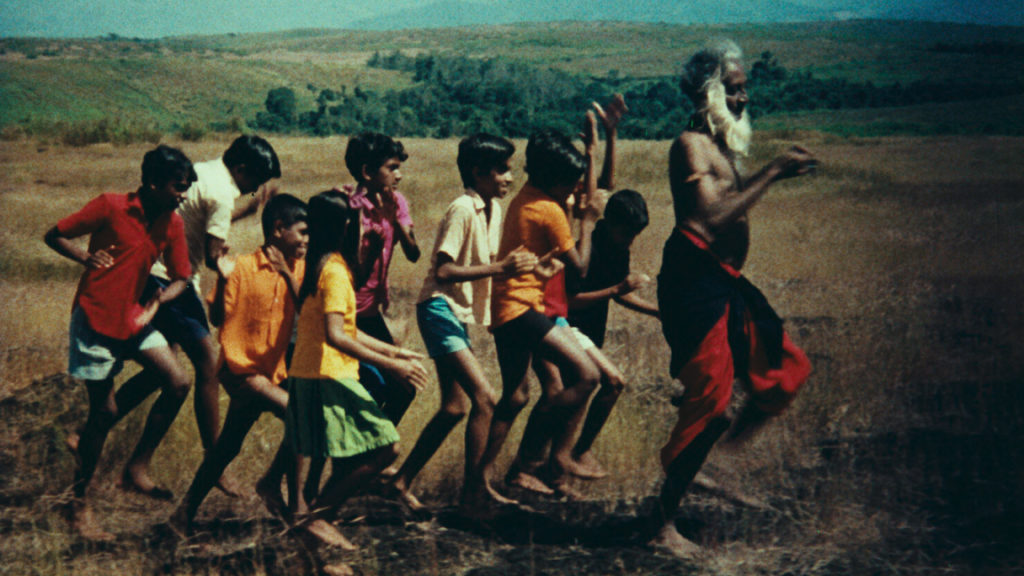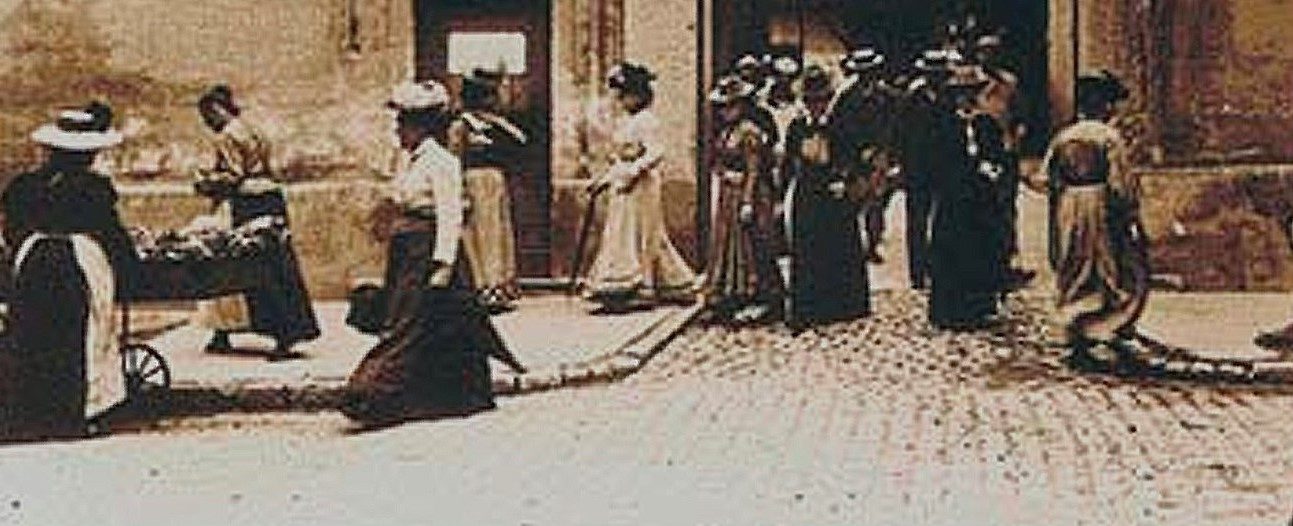India, 1979
Directed by Govindan Aravindan
With Rammuni (Kummatty), Kottara Gopalakrishnan Nair (Chinda)

The title refers to a character of the folk culture of the Malabar region, in the Indian state of Kerala, an old man springing from nowhere, who comes across as an artist telling tales and singing songs, but turns out to be an uncanny magician. He fascinates the children, scaring them a little but also thrilling them a lot. In a song that the kids of the village where the story takes place sing, and which seems to have the effect of conjuring up Kummatty, he is readily associated with myth and called “the Kummatty of our fairy tales”. And when the man materializes, kids are in awe, barely daring to come close to him, but quick to watch his every move. One of them, however, walks to him and accepts a gift. Chinda then convinces his friends to tag along the odd man, and they spend more and more time with him, dancing to his tunes and romping in the fields with him, neglecting their homework, as bitterly noted by Chinda’s mother.
But that maybe what they hanker after, the great mojo of this magician: disrupting the routine, putting a spell on the ordinary life of a village, letting the fancies of the children and their spirited and zesty ways prevail over habits and rules. Their environment, however, is not really depressing, a bit dull perhaps, but nestled into a wider, splendid world. The film spends a long time tracking the children as they play all over the village, go to school, stay with their families (though this point is mainly illustrated by Chinda’s life). And their activities, often in long shots, are placed in a wide frame, a long, breathtaking view of nature, both on Earth and in the sky – the film actually starts with a long take on a gorgeously shot sunset, the glowing, reddish sun surrounded by a lushly dark sky, with black clouds, an arresting heavenly view that gives way to huge landscapes in a delicate brown and green palette. The Kerala countryside is celebrated as a natural wonder, a magnificent share of the cosmos that is still a pleasant shelter to the quiet lives of men.
But Kummatty is busy, and must leave the village to go elsewhere. To please the fawning children, he performs a real, stunning magic trick – so far, he has done little, except drawing dates from Chinda’s ear; actually, he looked like a simple, weak human, showing eccentric behaviors but also getting badly sick, so badly that Chinda rushes to call the local medicine man. So he uses the masks he always carries in a bag to turn the kids into animals. But Chinda, who is now a dog, foolishly runs away, and so misses the moment when the other kids are reverted back to their true nature. The fairy tale the children used to expect in their tunes becomes a nightmare for, ironically, the one who was the most devoted to Kummatty. The film moves to a far more poignant narrative, the tale of a little white dog hopelessly looking for home, and then for an end to the spell. The new Chinda, like his parents, would have to wait for the return of Kummatty, one year later, to be changed back into the bright, clever kid he used to be, and was so delightful to watch.
The unfortunate incident, which injects somber and disturbing notes into what has been so far a merry and moving chronicle of childhood, compels Chinda and the audience to have another look at the lives of animals and the expectations of the humans. But because things have gone awry, the dreamed fairy tale, eventually, delivers the kind of moral concluding a fable. Chinda sets free the parakeet he keep in a cage, a funny companion of his childhood that revealed itself as a companion of misery when the kid was a dog – a stunning scene of dialogue between animals that is not handled with a whiff of anthropomorphism but is a most tender observation of animals. The freed parakeet flies high in the sky, joins other birds, and the final shots show a clear blue sky where droves of birds are endlessly scudding and regrouping, massive and majestic flocks making up ever-changing dark shapes, a ballet of lines swiping the screen. This astonishing Malayalam film ends as it began, high in the skies, but the wonder of light and darkness gives way to the emotion of air and motion. The message seems to be that the cosmos is even more appreciated when liberty is complete; nature remains the frame enabling men to live in full; magic is one way to get close to it.
Kummatty is not the only one wielding masks: a sequence details how a little girl has her face painted and gets lavish costumes to play a key role in a religious festival, surrounded by adults wearing masks, the purpose being to call upon divinity to help the crops grow. The film emphasizes the bond between humans, nature, and the more spiritual dimension that could exist along the known world. It bears witness to the beliefs of the Malabar rural population, in fact celebrates them, and the titular character is not painted as absolutely dangerous, even though the images of the Pied Piper and the Bogeyman come to mind for a Western spectator, especially as the carefree adventure turns into a disaster for Chinda (“The Bogeyman” is the title that has been used in English for the film). The story of Chinda, from his discovery of Kummatty to the saddest days of his life as a dog, is a touching as well as terrible narrative arc, where the kid gets closer to the tenets and visions shaping his native milieu and culture, grasping through tragic consequences and wonderful moments how precious and complicated are the ties between nature, man, and that other side of reality, magic, divine, cosmic, or whatever name that could fit. It is a magnificent film that displays the skills, flair, intelligence of Govindan Aravindan, a man of many talents (from painting to writing), a key figure of the Malayalam culture, a filmmaker whose career was too short and not as widely known as it should, an artist who found in this case a masterful collaborator, cinematographer Shaji N. Karun.

